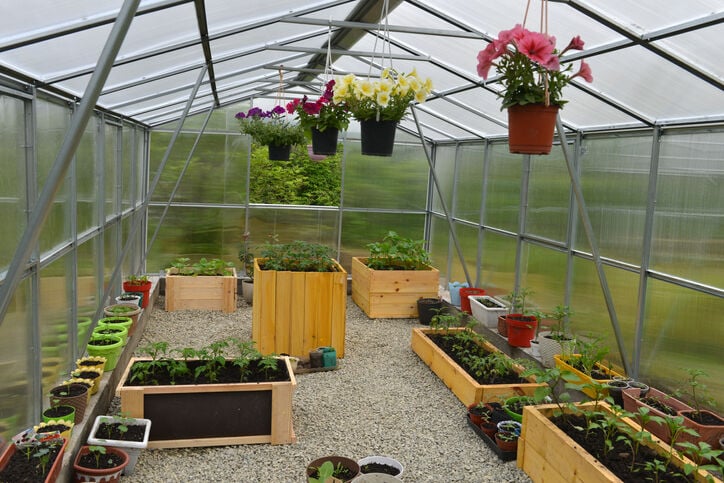In other parts of the country, greenhouses are chiefly used for keeping plants warm. Gardeners in cold climates can get a head start on their vegetables, grow plants too tender for their climate zone, and enjoy greenery when it's cold and wintry outside. In Tucson, a greenhouse can serve a somewhat different purpose.
There are four main reasons to have a greenhouse in the desert:
- To grow tropical plants (like banana or papaya) or specialty plants (like orchids or adeniums) so that you can provide them with an environment more conducive to growth.
- To grow cool season vegetables in the warmer months.
- To get a head start on some plants (like tomatoes) that require a lot of time to grow from seed and need to be started in the middle of winter.
- To house a collection of plants, like succulents or cacti, particularly if you want to protect them from plant-eating critters.
Greenhouses in our desert climate can have some major challenges, the chief ones being our extreme sun, heat, and dryness. In the summer, it’s difficult (and expensive) to provide an adequately cool and moist environment for many non-native plants.
Pima County Master Gardeners Dru Ann Duncan and Gary Vender have a 10-foot tall, 10-by-12 foot polycarbonate and aluminum frame greenhouse which they got second hand a couple of years ago. They use it to grow tomato plants from seed, which require a long time to mature and thus need to be planted in December in order to have fresh tomatoes before the summer heat hits.
According to Duncan, a greenhouse that is used in the summer will need 40% shade cloth, venting in the roof, and some type of moisture. You will be watering your plants, but in the heat of the late spring and summer you will need additional moisture to prevent plants in the greenhouse from overheating and dying. You can use an evaporative cooler, but this can increase your water bill substantially. A greenhouse with easily removable panels is also recommended so that you can control the inside temperature more easily in the summer months. Vender says he monitors the temperature in his greenhouse daily with thermometers.
Another challenge, and one that Duncan and Vender have first-hand experience with, is our spring and summer winds. A greenhouse (particularly one made of polycarbonate panels with an aluminum frame) is very light, and can easily be picked up by the wind if not anchored properly. The wind can also lift out the polycarbonate panels and blow them away or damage them. “The high winds and microbursts we have in Arizona can be devastating to a greenhouse,” Vender says. He and Duncan recommend positioning your greenhouse so that the openings are aligned with the North-South line to minimize wind damage, and anchoring it firmly to the ground.
Ideally, a gardener would have a glass greenhouse with a stronger frame, but these can be much more expensive. To save money, you can look at DIY greenhouse plans on the internet if you want to build your own out of wood and salvaged glass. Greenhouses covered with plastic sheeting are unlikely to do well in our strong winds, unless placed in a very sheltered spot.
In the desert, Vender says, it’s easier to heat a greenhouse than to cool it. For this reason, some greenhouse owners only use their greenhouse in the cooler months, for example for seedling starts or for tropical plants, and leave it unused in the summer. For heating in the winter you may be able to make your own clay pot candle heaters. In a very small space, old-fashioned incandescent light bulbs can also provide a fair amount of heat, although quite inefficiently.
Duncan and Vender use solar panels and their home’s electricity to run fans during warmer weather and heaters in the winter. Whatever setup you choose for your greenhouse, make sure there is a backup system in place in case of a power failure. A few hours of freezing (or extremely hot) temperatures could kill all of your precious plants. Duncan suggests putting your greenhouse up against a wall of the house for better temperature control and wind protection.
Knowing what they know now, Vender and Duncan would choose a lower greenhouse. “If I had to do it over again, I would have maybe 7 feet [of height] in the center instead of 10,” says Vender. “Something long and skinny would be better than something tall ... your ability to cool and heat it would be much easier.”
He suggests that gardeners look at extra climate-controlled space in their house before investing in a greenhouse.
“An extra bedroom or an Arizona room might be more economical” than purchasing and trying to heat or cool a separate outdoor greenhouse, he says. This year they opted to use an extra bedroom in their home for seedling starts.
Ultimately, your greenhouse setup will depend on what you use it for. If you have (or want to start) an extensive specialty plant collection, extra expense for a climate-controlled sturdy greenhouse may be warranted. On the other hand, if you just need a space for seedling starts and plant propagation, which would be used in winter only, you can probably get away with a smaller, inexpensive sheltered space.
For more information, check out these other resources:





